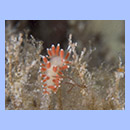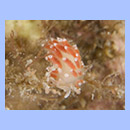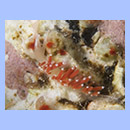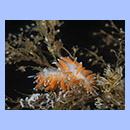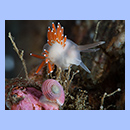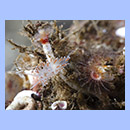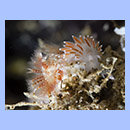- Kingdom: Animalia
- Phylum: Mollusca
- Class: Gastropoda
- Subclass: Heterobranchia
- Order: Nudibranchia
- Suborder: Dexiarchia
- Infraorder: Aeolidida
- Superfamily: Flabellinoidea
- Family: Coryphellidae
- Scientific name: Microchlamylla gracilis
- Norwegian: -
Characteristics:
This tiny nudibranch is hard to spot, due to its modest size. It rarely exceeds a body length of 15 mm. The white tipped cerata are usually filled with an orange or red digestive gland. Other color variations, including shades of green or brown, exist as well. The body has a white, translucent color. It may be confused with small individuals of other Flabellina species, but the cerata are perhaps more distinctly arranged in two rows than most other species. The head tentacles and the tips of the cerata have white pigmentation spots. On the tail similar pigmentation tends to form a fine line. The rhinophores are smooth. This species may be confused with small individuals of some of the other Flabellinoidea species:
- F. browni has smooth or slightly wrinkled rhinophores. The cerata are arranged in groups rather then rows. There is a white pigmented ring around the tip of the cerata. There is not a pink tint on the tentacles.
- B. nobilis has rounded papillae on the rhinophores. The cerata are not split in groups.
- C. pellucida has red or orange, white tipped cerata. The rhinophores are wrinkled. There are white pigmentation on the tentacles.
- C. verrucosa has wrinkled rhinophores, usually with a white pigmented line. There may be a pink tint on the white-tipped cerata. Individuals with long cerata may be confused with many of the other Flabellina species.
Habitat:
It thrives on sheltered, but current exposed locations, from the tidal zone and down to 120 meters. It is reported to feed on Eudendrium spp.
Distribution:
This is a species from the North Atlantic Ocean, from Iceland and Norway to France and from Newfoundland to New England.
